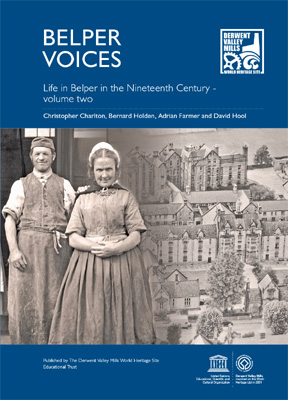
There is much in this book that breaks new ground. The Strutt’s built and owned much of the town but they needed competent men to manage what they had created. As the book describes, their town enjoyed the benefit of three generations of administrators from the Pym family. They ran the magistrates court, the Belper Poor Law union, project managed the building of the cemetery, nurtured the water and gas companies and much else besides. A Pym is recorded in a position of authority in 1803 and so it was when the century reached its end. The book also considers how the town looked after the poor. It describes the patchwork of individual philanthropy , Friendly Societies, a savings bank and soup kitchens that emerged, some of it from the hand of one of the Strutts, but much of it from the tradesmen and other residents.
The safety net could not save all who struggled to make ends meet; for some, pauperism became their only option. The Guardians offered out relief to some and incarceration to others. This study explains how the Belper Workhouse came into being. Designed by Scott and Moffat it is acknowledged to be among the finest built. So easily it could have been a prosaic structure from among the model designs offered by Sampson Kempthorne had not the Guardians seen Scott and Moffat’s work at Boston and realised they must abandon Kempthorne.
The workhouse though feared initially as “the bastile” (sic), became in time a refuge for the elderly and the orphans, part hospital, part orphanage, part school. It also accommodated an increasing and unwelcome influx of vagrants. The Belper Guardians emerge from these pages as men trying to do their best for both the poor in their care and the ratepayers to whom they owed their election. They were sometimes effronted and often bewildered by the orders they received from the central authority in London and in the 1870s and 1880s by the policies their ex officio colleague, the Honourable Frederick Strutt, brought to their table. Strutt became known as the man who sought to abolish out relief. For him the place for paupers was in the workhouse! The Guardians however clung on to their established policy. Granting out relief to local paupers was for them a form of patronage; about the only perk of office they felt they had left.

This is the Trust’s second book devoted to life in Belper in the nineteenth century. Thanks to the Trust securing generous financial support it is substantially larger than its predecessor. It retains the format that has become a hallmark of the Trust’s publications with copious illustrations and extensive quotations from contemporary sources. There is much in the book that breaks new ground. It features the extraordinary contribution to the development of the town, its administration and the shaping of its essential services by three generations of the Pym family. Other chapters describe the strategy the young town adopted to look after its poor creating a patchwork of individual philanthropy and self help while for those who sank into absolute poverty there was the workhouse. The building of the Belper Workhouse ( known now as the Babbington Hospital ) is described in detail. This account is accompanied by episodes from its later life as the Guardians who administered the Poor Law struggled with the challenges of unwelcome commands from London and disagreements within their own ranks as to where help was to be given. Should they, as the honourable Frederick Strutt demanded, deny money to the wives and families of men who were in prison? How the Guardians responded to this and many of Strutt’s other propositions is all in the book.
View details...
This is the first of two books describing life in Belper in the nineteenth century. These were the years that saw the town establish itself within the county as an administrative centre and, with its early railway connection, a flourishing horse-nail industry, and the seemingly inexorable growth of the Strutts' empire, what could go wrong? But the railway didn't bring investment; handcrafted nails were overtaken by those made by machine and then by imported products; and the mills contracted and were sold. The growth of the town stalled.
View details...